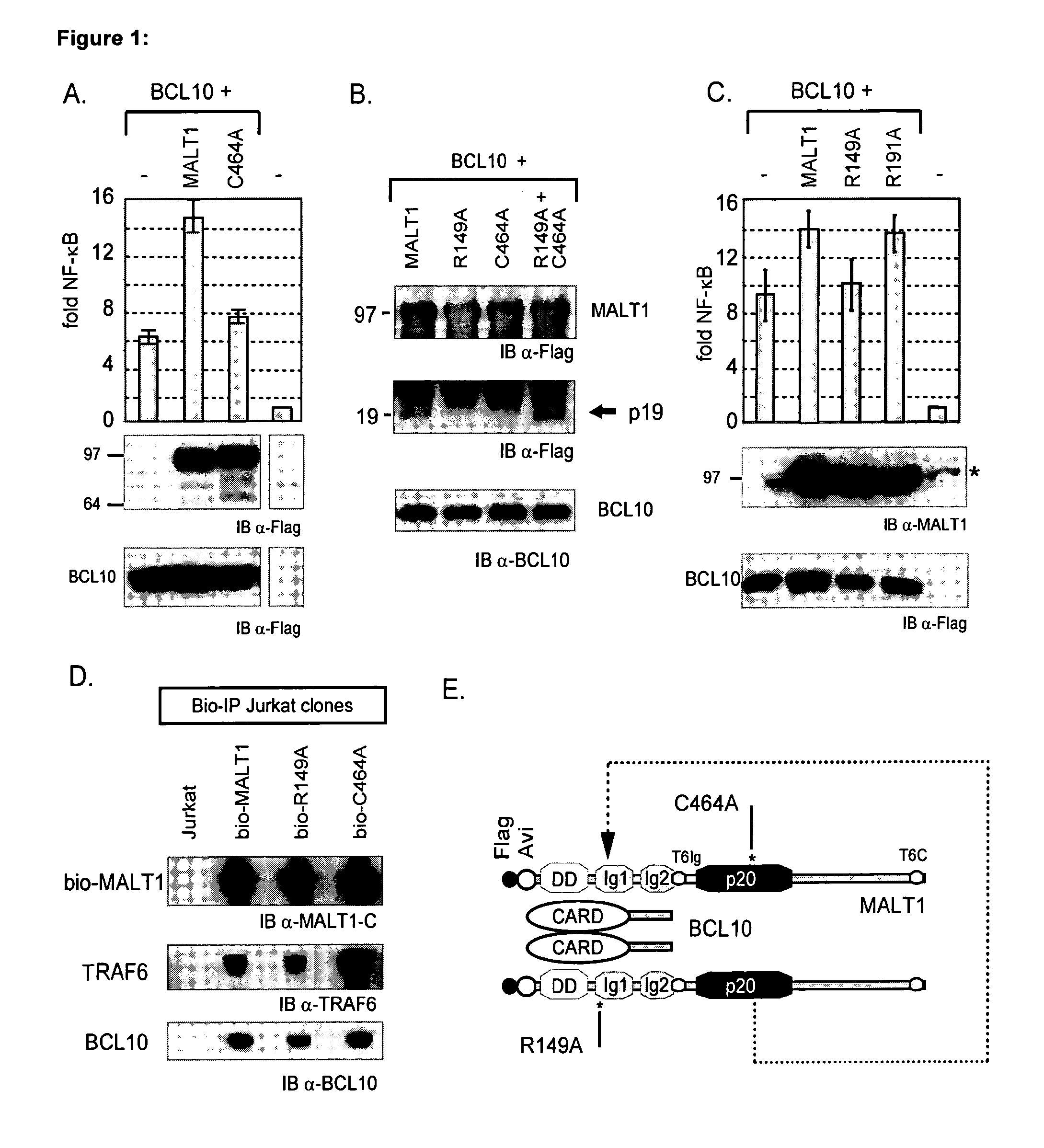Inhibitors of malt1 proteolytic activity and uses thereof
a proteolytic activity and inhibitory technology, applied in the direction of peptides, drug compositions, immunological disorders, etc., can solve the problems of malt1 paracaspase's proteolytic activity not generally accepted, uncontrolled and stimulus-dependent activation of nfb, etc., and achieve the effect of comparing the digestion of the substra
- Summary
- Abstract
- Description
- Claims
- Application Information
AI Technical Summary
Benefits of technology
Problems solved by technology
Method used
Image
Examples
example 1
The MALT1 p20 Domain has Auto-Proteolytic Activity
[0038]The MALT1 protein synergistically activates NFκB with BCL10 when co-expressed in 293T cells. Human MALT1 contains a caspase p20-like domain. Interestingly, mutation of the putative catalytic cysteine (C464A) in this domain reduced the synergism with BCL10 (Lucas et al., 2001 and FIG. 1, Panel A), hypothesizing that BCL10-mediated dimerization of MALT1 might initiate NFκB signaling via activation of its caspase p20-like domain.
[0039]To investigate whether BCL10-mediated dimerization of MALT1 induces its auto-proteolysis, we performed streptavidin-mediated pull-downs of MALT1 with an N-terminal tag. Western blot analysis indeed showed the presence of an N-terminal fragment of 19 kDa (p19), which was absent without BCL10 co-expression or when BCL10 was co-expressed with the C464A MALT1 mutant (FIG. 1, Panel B).
[0040]Metacaspases have specificity towards R / K residues in the substrate P1 position (Vercammen et al., 2004). Based on t...
example 2
Raft Association of MALT1 is Sufficient for Cleavage into p19 and p76 Fragments
[0042]Previously we demonstrated that BCL10 co-expression induced the redistribution of MALT1 to the lipid rafts in 293T cells (Noels et al., 2007). We induced raft association of MALT1 in 293T cells by adding a myristoylation-palmitoylation signal sequence (mp-MALT1). This was sufficient to activate an NFκB luciferase reporter gene and to generate the p19 fragment, whereas ectopic expression of MALT1 was not able to do so (FIG. 2, Panel B). Western blot analysis of detergent resistant membrane fractions confirmed the association of mp-MALT1 with the lipid rafts, in contrast to MALT1 shown previously to reside exclusively in cytosolic fractions (Noels et al., 2007; Baens et al., 2006), and the p19 fragment was detected in raft fractions) as well as in total cell lysates (FIG. 2, Panel C). Again no p19 was detected upon expression of either R149A- or C464A-mp-MALT1, whereas their co-expression restored p19...
example 3
MALT1 Paracaspase Shows In Vitro Proteolytic Activity
[0044]Caspases efficiently cleave synthetic substrates consisting of a four amino acid recognition sequence linked, via the carboxy-terminal aspartate, to a fluorogenic amine. Based on the presumed cleavage site of MALT1, Ac-LCCR-AMC (see SEQ ID NO:15) would be a suitable substrate for demonstrating MALT1 paracaspase activity in vitro. As the synthesis of a LCCR (SEQ ID NO:15) peptide is difficult, we first demonstrated that mutating both C147 and C148 in MALT1 to S, resulted in a LSSR (SEQ ID NO:1) MALT1 mutant that could still be cleaved in cellular assays (FIG. 3, Panel A). Next we showed that bio-IP purified MALT1 was indeed able to cleave Ac-LSSR-AMC (see SEQ ID NO:1) in vitro, whereas bio-1P purified C464 mutant was not (FIG. 3, Panel B). Bio-IP of mock-transfected cells also showed no activity, which together with the results for bio-IP-purified C464A MALT1 excludes precipitation of a contaminating protease. Interestingly t...
PUM
 Login to View More
Login to View More Abstract
Description
Claims
Application Information
 Login to View More
Login to View More - R&D
- Intellectual Property
- Life Sciences
- Materials
- Tech Scout
- Unparalleled Data Quality
- Higher Quality Content
- 60% Fewer Hallucinations
Browse by: Latest US Patents, China's latest patents, Technical Efficacy Thesaurus, Application Domain, Technology Topic, Popular Technical Reports.
© 2025 PatSnap. All rights reserved.Legal|Privacy policy|Modern Slavery Act Transparency Statement|Sitemap|About US| Contact US: help@patsnap.com



